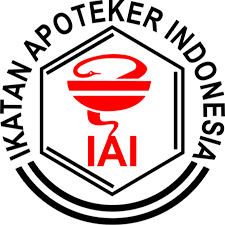Formulation of Nifedipine–Polyvinyl Pyrrolidone (PVP) Solid Dispersion System and Intrinsic Dissolution Rate Evaluation
Riza Maulana(1*), Henry Harto(2), Tiara Dewi Salindri Pratama(3)(1) Department of Pharmaceutics, Faculty of Pharmacy, Universitas Muhammadiyah Surakarta, Surakarta, Indonesia
(2) Department of Research and Development, PT Mahakam Beta Farma, Jakarta, Indonesia
(3) Department of Pharmacy, Faculty of Mathematics and Sciences, Universitas Sebelas Maret, Surakarta, Indonesia
(*) Corresponding Author
Abstract
Keywords
Full Text:
PDFReferences
Alves, L.D.S., de La Roca Soares, M.F., de Albuquerque, C.T., da Silva, É.R., Vieira, A.C.C., Fontes, D.A.F., Figueirêdo, C.B.M., Soares Sobrinho, J.L., and Rolim Neto, P.J., 2014. Solid dispersion of efavirenz in PVP K-30 by conventional solvent and kneading methods. Carbohydrate Polymers 104, 166–174. https://doi.org/10.1016/j.carbpol.2014.01.027
Charalabidis, A., Sfouni, M., Bergström, C., and Macheras, P., 2019. The Biopharmaceutics Classification System (BCS) and the Biopharmaceutics Drug Disposition Classification System (BDDCS): Beyond guidelines. International Journal of Pharmaceutics 566, 264–281. https://doi.org/10.1016/j.ijpharm.2019.05.041
Febriyenti, F., Rahmi, S., and Halim, A., 2019. Study of Gliclazide Solid Dispersion Systems Using PVP K-30 and PEG 6000 by Solvent Method. J Pharm Bioallied Sci 11, 262–267. https://doi.org/10.4103/jpbs.JPBS_87_18
Fitriani, L., Haqi, A., and Zaini, E., 2016. Preparation and characterization of solid dispersion freeze-dried efavirenz – polyvinylpyrrolidone K-30. J Adv Pharm Technol Res 7, 105–109. https://doi.org/10.4103/2231-4040.184592
Frizon, F., Eloy, J. de O., Donaduzzi, C.M., Mitsui, M.L., and Marchetti, J.M., 2013. Dissolution rate enhancement of loratadine in polyvinylpyrrolidone K-30 solid dispersions by solvent methods. Powder Technology 235, 532–539. https://doi.org/10.1016/j.powtec.2012.10.019
Fudholi, A., 2013. Disolusi Dan Pelepasan Obat In-Vitro. Pustaka Pelajar, Yogyakarta.
Hadžiabdić, J., 2013. The Solubility - Intrinsic Dissolution Rate of Diazepam and Inclusion Complexes Diazepam with 2-Hydroxypropyl-β-Cyclodextrin. International Journal of Science, Technology and Society 1, 24. https://doi.org/10.11648/j.ijsts.20130101.14
Huang, Y., and Dai, W.-G., 2014. Fundamental aspects of solid dispersion technology for poorly soluble drugs. Acta Pharmaceutica Sinica B, SI: Drug Delivery System and Pharmaceutical Technology 4, 18–25. https://doi.org/10.1016/j.apsb.2013.11.001
Jagtap, P.S., Tagad, R.R., and Shendge, R.S., 2019. A brief review on Kollidon. Journal of Drug Delivery and Therapeutics 9, 493–500. https://doi.org/10.22270/jddt.v9i2.2539
Khoder, M., Abdelkader, H., ElShaer, A., Karam, A., Najlah, M., and Alany, R.G., 2018. The use of albumin solid dispersion to enhance the solubility of unionizable drugs. Pharmaceutical Development and Technology 23, 732–738. https://doi.org/10.1080/10837450.2017.1364267
Kothari, K., Ragoonanan, V., and Suryanarayanan, R., 2015. The Role of Drug–Polymer Hydrogen Bonding Interactions on the Molecular Mobility and Physical Stability of Nifedipine Solid Dispersions. Mol. Pharmaceutics 12, 162–170. https://doi.org/10.1021/mp5005146
Nader, A.M., Quinney, S.K., Fadda, H.M., and Foster, D.R., 2016. Effect of Gastric Fluid Volume on the In Vitro Dissolution and In Vivo Absorption of BCS Class II Drugs: a Case Study with Nifedipine. AAPS J 18, 981–988. https://doi.org/10.1208/s12248-016-9918-x
Nair, A.R., Lakshman, Y.D., Anand, V.S.K., Sree, K.S.N., Bhat, K., and Dengale, S.J., 2020. Overview of Extensively Employed Polymeric Carriers in Solid Dispersion Technology. AAPS PharmSciTech 21, 309. https://doi.org/10.1208/s12249-020-01849-z
Noval, N., and Malahayati, S., 2021. Teknologi Penghantaran Obat Terkendali. https://doi.org/10.31237/osf.io/jfwnp
Salman, Ardiansyah, Nasrul, E., Rivai, H., Ben, E., and Zaini, E., 2015. Physicochemical characterization of amorphous solid dispersion of ketoprofen–polyvinylpyrrolidone K-30. International Journal of Pharmacy and Pharmaceutical Sciences 7, 209–212.
Saraf, I., Roskar, R., Modhave, D., Brunsteiner, M., Karn, A., Neshchadin, D., Gescheidt, G., and Paudel, A., 2022. Forced Solid-State Oxidation Studies of Nifedipine-PVP Amorphous Solid Dispersion. Mol. Pharmaceutics 19, 568–583. https://doi.org/10.1021/acs.molpharmaceut.1c00678
Sareen, S., Mathew, G., and Joseph, L., 2012. Improvement in solubility of poor water-soluble drugs by solid dispersion. Int J Pharm Investig 2, 12–17. https://doi.org/10.4103/2230-973X.96921
Shah, N., Iyer, R.M., Mair, H.-J., Choi, D., Tian, H., Diodone, R., Fahnrich, K., Pabst-Ravot, A., Tang, K., Scheubel, E., Grippo, J.F., Moreira, S.A., Go, Z., Mouskountakis, J., Louie, T., Ibrahim, P.N., Sandhu, H., Rubia, L., Chokshi, H., Singhal, D., and Malick, W., 2013. Improved Human Bioavailability of Vemurafenib, a Practically Insoluble Drug, Using an Amorphous Polymer-Stabilized Solid Dispersion Prepared by a Solvent-Controlled Coprecipitation Process. Journal of Pharmaceutical Sciences 102, 967–981. https://doi.org/10.1002/jps.23425
Shaik, J., Shaik, S., Alaparthi, N., Bachupally, A., and Punuru, M., 2013. Formulation And Evaluation Of Mefenamic Acid Solid Dispersions Using PEG-4000. International Research Journal of Pharmacy 4, 155–159. https://doi.org/10.7897/2230-8407.04532
Teleki, A., Nylander, O., and Bergström, C.A.S., 2020. Intrinsic Dissolution Rate Profiling of Poorly Water-Soluble Compounds in Biorelevant Dissolution Media. Pharmaceutics 12, 493. https://doi.org/10.3390/pharmaceutics12060493
Van den Mooter, G., 2012. The use of amorphous solid dispersions: A formulation strategy to overcome poor solubility and dissolution rate. Drug Discovery Today: Technologies, Formulation technologies to overcome poor drug-like properties 9, e79–e85. https://doi.org/10.1016/j.ddtec.2011.10.002
Yuwono, T., 1987. Pengaruh kofeina terhadap kelarutan dan ketersediaan hayati O-Etoksibenzamida padat tikus jantan (Doctoral dissertation, Institut Teknologi Bandung, Bandung).
Zidan, H.M., Abdelrazek, E.M., Abdelghany, A.M., and Tarabiah, A.E., 2019. Characterization and some physical studies of PVA/PVP filled with MWCNTs. Journal of Materials Research and Technology 8, 904–913. https://doi.org/10.1016/j.jmrt.2018.04.023
Article Metrics
Abstract view(s): 835 time(s)PDF: 864 time(s)
Refbacks
- There are currently no refbacks.








